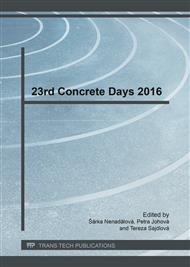p.135
p.140
p.146
p.152
p.158
p.164
p.173
p.178
p.184
Effects of Differential Shrinkage in Concrete Bridges
Abstract:
The effects of the external environment significantly affect the distribution of stress in concrete bridges. Diffusion of humidity and temperature fluctuations, as a result of the effects of the external environment, result in the emergence of a very complex state of stress and strain in the elements of concrete bridges and the creation of acceptable or unacceptable cracks. In order to predict these correctly, one must use a creep and shrinkage model that realistically describes the moisture diffusion process, which causes that the shrinkage and drying creep of the bulky parts of the box cross section are greatly delayed compared to the thin parts. This delay cannot be predicted with the classical approach, in which either the shrinkage strain and the creep coefficient (or compliance function) are considered as uniform throughout the cross section, or the thickness effect is simply described by a multiplicative factor on shrinkage strain. With full respect for these phenomena the bridge of a double T section segmental bridge is analyzed.
Info:
Periodical:
Pages:
158-163
Citation:
Online since:
May 2017
Authors:
Keywords:
Price:
Сopyright:
© 2017 Trans Tech Publications Ltd. All Rights Reserved
Share:
Citation:


